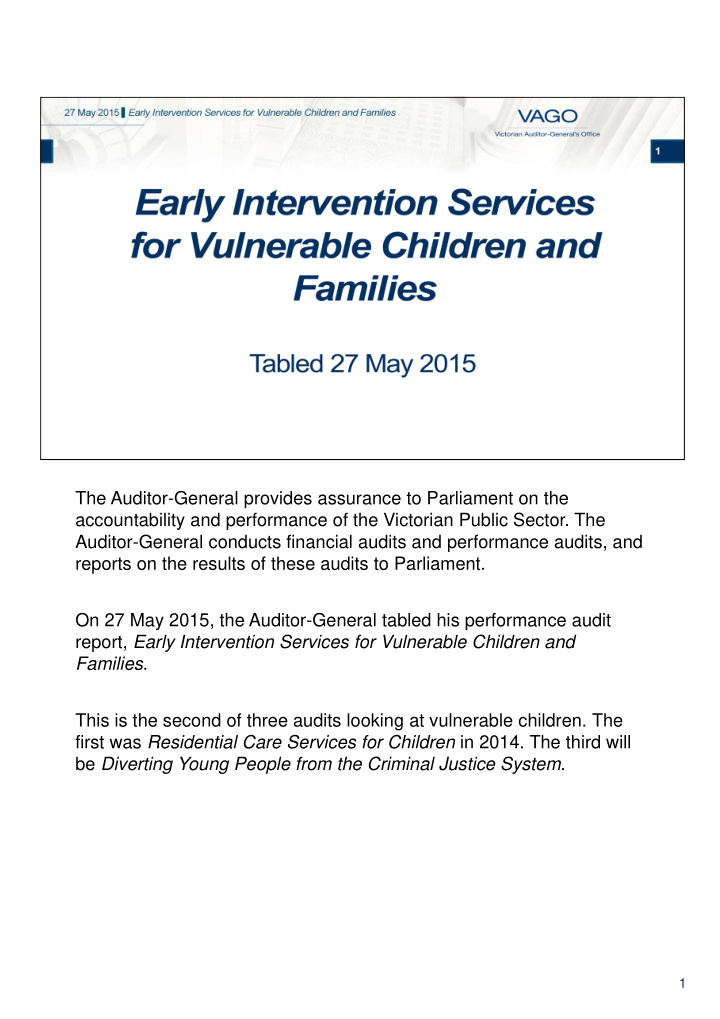



The Auditor-General provides assurance to Parliament on the accountability and performance of the Victorian Public Sector. The Auditor-General conducts financial audits and performance audits, and reports on the results of these audits to Parliament. On 27 May 2015, the Auditor-General tabled his performance audit report, Early Intervention Services for Vulnerable Children and Families . This is the second of three audits looking at vulnerable children. The first was Residential Care Services for Children in 2014. The third will be Diverting Young People from the Criminal Justice System . 1
Here are some contextual facts for our audit: • In 2013–14, one in 37 Australian children received child protection services. • Of these, 73 per cent were repeat clients. • In 2013–14, in Victoria, over 82 000 reports were made to the Victorian Child Protection Service (or Child Protection). • This represents a 92 per cent increase since 2008–09. 2
Early intervention services are critical. Without these, vulnerable children may end up on a trajectory through child protection, youth justice and the criminal justice system. The audit examined Child and Family Information, Referral and Support Teams—or Child FIRST—and Integrated Family Services—or IFS. We looked at whether vulnerable families can access Child FIRST and IFS and whether outcomes for families are improving. We found that: • Low- to moderate-risk families are missing out on these services. • The Department of Health & Human Services—or the department—does not measure outcomes for families. • The department needs to comprehensively review its approach to early intervention. 3
There are escalating interventions, as shown in this diagram: • Primary interventions are available to any family. • Secondary interventions focus on children and families where vulnerability has been identified. • And, Tertiary interventions target children and families with significant vulnerability. Often the children are already in child protection. • Child FIRST and IFS represent a secondary intervention. 4
In this diagram we show that Child FIRST acts as a referral gateway. Referrals come from a range of different sources. Families may be given advice and information during an initial screening assessment or referred for more comprehensive assessment and support from IFS. 5
The audit assessed whether: • vulnerable children and families can access these services as needed, and • services are improving outcomes for vulnerable children and families. It focused on the department’s oversight and leadership role. We also consulted with a selection of service providers. Without ‘follow-the-dollar’ powers we couldn’t look at how providers are using their funding. 6
We found strategic planning for Child FIRST and IFS to be reactive and rudimentary. • The department hasn’t forecast overall demand or responded promptly to emerging demand drivers. • It requires service providers to manage demand but hasn’t analysed the impact of these strategies when demand is high. • Increased demand means families with high needs are prioritised. Families with low or moderate needs are missing out, yet could benefit most from early intervention to divert from child protection. • Most service providers are not-for-profit organisations. In 2013–14, they delivered more services—the equivalent of $5.3 million—than funded for. The department doesn’t know if this is because of goodwill, inefficiency or mis-reporting. The department needs to better plan for demand and act promptly on issues affecting service delivery. 7
Child FIRST and IFS rely on multiple providers to deliver services. Training and resources are needed to create strong collaborative partnerships. Currently there is great variability across alliance partnerships. • Weak partnerships and inadequate governance arrangements have impeded integrated and coordinated service delivery. • Over time engagement between the department and the service sector has weakened. To improve access and outcomes, the department needs to better support the development of partnerships and governance, and communicate better across different departmental levels and with the sector on operational and strategic issues. 8
The department focuses on outputs such as number of cases and service hours. It doesn’t monitor outcomes for vulnerable families. Its Integrated Reports and Information System—called IRIS—collects service data from Child FIRST and IFS but has significant limitations. The department does little system level analysis of how services perform, which seriously affects its strategic planning. The department needs to do more to monitor program risks, address and identify key performance issues, and measure outcomes. 9
Our overarching recommendation is that the Department of Health and Human Services conducts a thorough review of its approach to early intervention. This is supported by 9 specific recommendations: • Recommendations 1 and 4 focus on improving demand forecasting and reviewing funding. • Recommendations 2, 6, and 7 focus on better engagement with the service sector to respond effectively to emerging issues. • Recommendations 3 and 5 are about strengthening partnerships. And • Recommendations 8 and 9 are about using analytical tools and sharing good practice. 10
The department accepted all recommendations and has included a comprehensive action plan in Appendix B of the report. The Auditor-General will monitor this progress over time. 11
In summary, increased demand means Child FIRST and IFS must focus on families with high needs. Families at low or moderate risk miss out. The department needs to improve its planning, partnerships, governance arrangements, communication, and sector engagement. It needs to do systematic data analysis, address key performance issues, and measure outcomes. 12
Our overall message is that the department needs to make sure children and families receive intervention early enough to divert from child protection. 13
Relevant audits are listed on this slide. 14
All our reports are available on our website. If you have any questions about this or other reports, or anything else you would like to discuss with us including ideas for future audit topics, please call us on 03 8601 7000 or contact us via our website. 15
Recommend
More recommend